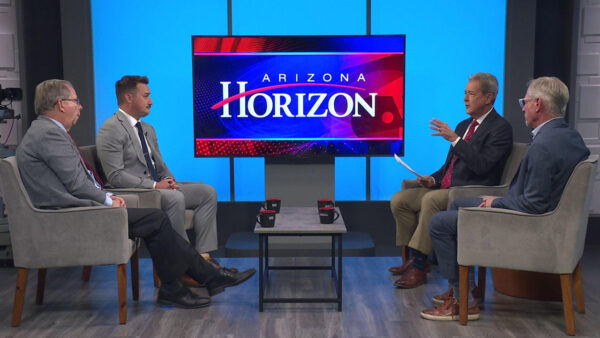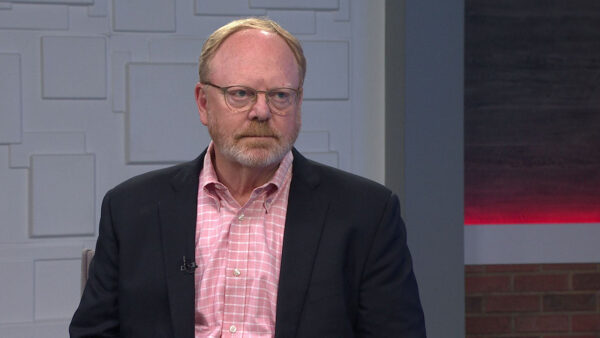An effort is underway to connect schools’ STEM programs in a community of practice, which will allow the schools to share best practices, leverage opportunities and collaborate to progress STEM education in Arizona. Communities of practice are used with effectiveness in workplaces. Jeremy Babendure, executive director of the Arizona SciTech Festival, will discuss the effort, along with Janet McConnell, an instructional developer and designer for Intel. Babendure will also briefly discuss the ongoing SciTech Festival.
Ted Simons: Tonight's edition of Arizona technology and innovation looks at an effort to connect science, engineering and math programs in a way that shows schools ways to better collaborate and share teaching practices. Here with more is Jeremy Babendure, executive director of the Arizona Sci-Tech Festival, and Janet McConnell, an instructional developer and designer for Intel. Good to have you both here. Thank you for joining us. A stem school community of practice. Definition, please.
Jeremy Babendure: Right, so let me give you more context of how it forms. Janet could probably talk more about community practice and what they are. My role with Arizona Sci-Tech, we built statewide largest celebration of science and technology. We work with about 800 organizations throughout the state. A lot of them are schools. People ask questions for advice, often they are schools, we want to start a new stem program, we want to put in after-school clubs. A lot of questions related to stem. How do we grow it in our schools? My typical response is I'm not an educator. You should talk to these other stem schools that are doing this. You've heard a lot of stem schools, Bio Science high schools, Crest Academy; they don't talk to each other that much, which to me is crazy. They are the ones with the expertise. We want to figure out how to get them to talk with each other and grow as a collective community.
Ted Simons: The difference then between a community of practice and the network.
Janet McConnell: A community of practice -- network is more social. It could be a community of practice but more than likely it's not. There will be a network inside a community of practice. Let me give you an example. This is one that I use all the time. There's several people sitting around a lunch table and one person says, I'm having this trouble with this widget. Somebody else says I had that same trouble. Here's what I did. The third says I haven't had that trouble but what if you did this instead? That is learning. They all have a similar interest or passion in a particular topic, and then through collaboration through the sharing of knowledge what they come out of with that is something greater than any one of them has provided.
Ted Simons: Who decides which teams work together and share and collaborate?
Janet McConnell: The teams do. They decide; a community of practice is only as good as its members. If a member does not want to do say we don't want to plant corn, then why would we be trying to get them to plant corn? They are going to come to us and we're going to ask, what are the issues that you want to solve? Then we'll have like testing and that sort of thing. The whole thing is based on what is important to them. If it doesn't provide value it will unravel quickly and they are who determine if it has value or not.
Ted Simons: Oversight. What kind of oversight is involved here?
Jeremy Babendure: It depends on the community. So here it's been interesting how we have five organizations that have teamed up to make this happen. Arizona sci-tech. We reached out to Intel, who is the world leader in cultivating communities of practice. Arizona science center, Maricopa County service agency and we have national stem ecosystems that we're part of. That helps validate the importance of the group but in terms of who is calling the shots it's really important to have them almost create and cultivate their own community.
Ted Simons: Is a community existing right now?
Jeremy Babendure: That is one of the most things. You think there already is a community of schools working together and you have some communities in districts they work together, you may have a position but this is one of the first efforts and we found nationally nobody is doing this anywhere. It seems like an obvious idea, why hasn't anyone done this. We thought the same thing. Let's just try to make it happen.
Ted Simons: Why hasn't anyone done this?
Janet McConnell: Maybe the name is throwing them off. I'm not sure. Community of practice is the way to go. I would think it's that they don't know that there are other people out there with a similar situation or problem. You hear it time and time again. I didn't know that there were other people out there like this.
Ted Simons: So if I'm a parent, a school principal or a teacher, if I'm any one of those and I'm hearing about this saying I want to get involved in this. How do I get involved? How do I make sure this isn't just a big waste of time and a bunch of folks getting nothing done?
That's why there is a facilitator or shepherd or whatever you want to say it. I won't be telling them what to do, but I will guide them to keep them on track. We're going to work on what they want to work on but I'm going to kind of nudge them. I'm not going to let them bring it, draw it all out or anything like that. That's what my role is, to shepherd them, make sure they are moving at a pace that will keep interest.
Ted Simons: The role of industry in all this?
Jeremy Babendure: I think that's the coolest part. When you look at the literature, we were mentored by a group in D.C. that has a national network of stem ecosystems. It's actually liturature that has cultivated communities of practice better than anyone. Who is one of the industry leaders doing this? It's Intel. Why not engage them to help work with us in cultivating it.
Ted Simons: How can you measure the impact of these communities of practice?
Jeremy Babendure: I think it's looking at outcomes. Did a school engage with the community? Did they implement new practices, new professional development, do you have new collaborations they may do. There are may be things, like let's say a team comes together to figure out how to better promote our stem school, better fund themselves or what type of curriculum they want to do. I think it's about more connections and what they get out of those.
Ted Simons: Able to measure those things you think?
Janet McConnell: We can make links but we can't say conclusively. The bigot idea, the second and third guy when they have a widget problem they will do it much faster, solve it like that. But can we really say that it wasn't only because of that community of practice, right? So we can but it's a little bit gray.
Ted Simons: Yeah. All right. Well, good luck with this. Congratulations on the effort. Especially since no one's done it before. Real quickly, Sci-Tech Festival still going on?
Jeremy Babendure: Still going on. The month of March, tonight is an event called Geeks' Night out in downtown Tempe.
Ted Simons: All right. Wander around there. See a community, you know --
Jeremy Babendure: That's it.
Ted Simons: Good to have you both here.
Janet McConnell: Thank you.
Ted Simons: Thanks for joining.
Jeremy Babendure:Executive director of the Arizona SciTech Festival,Janet McConnell: An instructional developer and designer for Intel.























